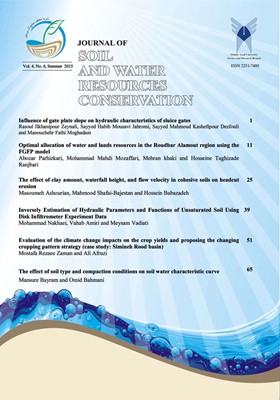The effect of clay amount, waterfall height, and flow velocity in cohesive soils on headcut erosion
Subject Areas : Farm water management with the aim of improving irrigation management indicators
Masoumeh Ashourian
1
,
Mahmood Shafai-Bajestan
2
,
Hossein Babazadeh
3
![]()
1 - Ph.D Student, Water Sci. and Eng. Dept., Science and Research Branch, Islamic Azad University, Tehran, Iran
2 - Professor, College of Water Science Engineering, Shahid Chamran University, Ahwaz, Iran
3 - Associate professor, Water Sci. and Eng. Dept., Science and Research Branch, Islamic Azad University, Tehran, Iran
Keywords: gullies, Sediment, tensional cracks, waterfall slope angle,
Abstract :
Headcut erosion is a sudden change in height or slope, which creates gullies and valleys and depending on different factors, it may vary from a height range of less than one inch to some feet and move upstream. This is one of the most significant types of erosions in soil losses and the major sources of sediment yield. Therefore, knowing this phenomenon, migration rate and sediment yield are important. In this study, seven samples of cohesive soils with different compositions of clay and silt, tested under different circumstances of waterfall height and flow velocity, and discussed migration rate and sediment yield. Tests were continued to reach a constant migration rate. One of the effective phenomenons in all tests was tensional cracks on soil surface. The size and number of these cracks have inverse relation with clay percent. The higher is the adhesion of sediment, the more vertical is the angle of waterfall migration upward. Waterfall slope angle under pure clay conditions was 34.6 degrees, but it increased to 40 degrees in the soil with 50 percent clay. With the 50 percent clay reduction, headcut movement and its average velocity were 3 times more than the one with 10 percent reduction of clay. Moreover, waterfall decline, its mean velocity, and average flow rate of sediment increased by 3.5, 4.5, and 3 times, respectively.


